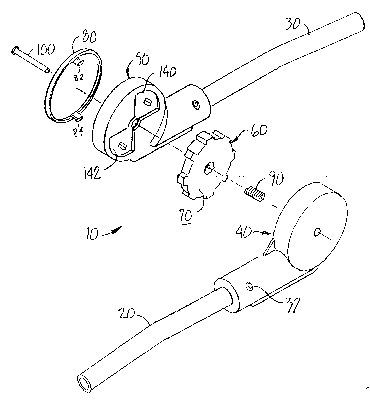Une partie des informations de ce site Web a été fournie par des sources externes. Le gouvernement du Canada n'assume aucune responsabilité concernant la précision, l'actualité ou la fiabilité des informations fournies par les sources externes. Les utilisateurs qui désirent employer cette information devraient consulter directement la source des informations. Le contenu fourni par les sources externes n'est pas assujetti aux exigences sur les langues officielles, la protection des renseignements personnels et l'accessibilité.
L'apparition de différences dans le texte et l'image des Revendications et de l'Abrégé dépend du moment auquel le document est publié. Les textes des Revendications et de l'Abrégé sont affichés :
| (12) Demande de brevet: | (11) CA 2171166 |
|---|---|
| (54) Titre français: | JOINT PLIANT TOURNANT AUTOUR D'UN AXE POUR PARCS POUR ENFANTS PLIANTS |
| (54) Titre anglais: | ROTATABLE BENDING JOINT FOR COLLAPSIBLE PLAYPEN |
| Statut: | Réputée abandonnée et au-delà du délai pour le rétablissement - en attente de la réponse à l’avis de communication rejetée |
| (51) Classification internationale des brevets (CIB): |
|
|---|---|
| (72) Inventeurs : |
|
| (73) Titulaires : |
|
| (71) Demandeurs : | |
| (74) Agent: | SMART & BIGGAR LP |
| (74) Co-agent: | |
| (45) Délivré: | |
| (22) Date de dépôt: | 1996-03-06 |
| (41) Mise à la disponibilité du public: | 1996-11-02 |
| Requête d'examen: | 1998-04-28 |
| Licence disponible: | S.O. |
| Cédé au domaine public: | S.O. |
| (25) Langue des documents déposés: | Anglais |
| Traité de coopération en matière de brevets (PCT): | Non |
|---|
| (30) Données de priorité de la demande: | ||||||
|---|---|---|---|---|---|---|
|
An improved rotatable joint of the kind
disclosed in U.S. Pat. No. 5,381,570 for foldable
tubular playpen frames having a step in the tooth of
a recessed sprocket portion in which a connecting
gear rests. In order to unlock the joint one must
move the gear axially inwardly with a pushbutton as
well as relieve the stresses on the joint by lifting
up the tubular bars connected to the joint so that
the gear may slip off the step. In this way an
additional factor of safety is built-in in order to
unlock the joint, and accidental release is reduced.
Note : Les revendications sont présentées dans la langue officielle dans laquelle elles ont été soumises.
Note : Les descriptions sont présentées dans la langue officielle dans laquelle elles ont été soumises.

2024-08-01 : Dans le cadre de la transition vers les Brevets de nouvelle génération (BNG), la base de données sur les brevets canadiens (BDBC) contient désormais un Historique d'événement plus détaillé, qui reproduit le Journal des événements de notre nouvelle solution interne.
Veuillez noter que les événements débutant par « Inactive : » se réfèrent à des événements qui ne sont plus utilisés dans notre nouvelle solution interne.
Pour une meilleure compréhension de l'état de la demande ou brevet qui figure sur cette page, la rubrique Mise en garde , et les descriptions de Brevet , Historique d'événement , Taxes périodiques et Historique des paiements devraient être consultées.
| Description | Date |
|---|---|
| Le délai pour l'annulation est expiré | 2003-03-06 |
| Demande non rétablie avant l'échéance | 2003-03-06 |
| Réputée abandonnée - les conditions pour l'octroi - jugée non conforme | 2002-03-19 |
| Réputée abandonnée - omission de répondre à un avis sur les taxes pour le maintien en état | 2002-03-06 |
| Un avis d'acceptation est envoyé | 2001-09-19 |
| Lettre envoyée | 2001-09-19 |
| Un avis d'acceptation est envoyé | 2001-09-19 |
| Inactive : Approuvée aux fins d'acceptation (AFA) | 2001-08-30 |
| Modification reçue - modification volontaire | 2001-02-22 |
| Inactive : Dem. de l'examinateur par.30(2) Règles | 2001-01-15 |
| Inactive : Acc. réc. RE - Pas de dem. doc. d'antériorité | 1998-07-22 |
| Inactive : Dem. traitée sur TS dès date d'ent. journal | 1998-07-21 |
| Inactive : Renseign. sur l'état - Complets dès date d'ent. journ. | 1998-07-21 |
| Toutes les exigences pour l'examen - jugée conforme | 1998-04-28 |
| Exigences pour une requête d'examen - jugée conforme | 1998-04-28 |
| Demande publiée (accessible au public) | 1996-11-02 |
| Date d'abandonnement | Raison | Date de rétablissement |
|---|---|---|
| 2002-03-19 | ||
| 2002-03-06 |
Le dernier paiement a été reçu le 2001-02-15
Avis : Si le paiement en totalité n'a pas été reçu au plus tard à la date indiquée, une taxe supplémentaire peut être imposée, soit une des taxes suivantes :
Veuillez vous référer à la page web des taxes sur les brevets de l'OPIC pour voir tous les montants actuels des taxes.
| Type de taxes | Anniversaire | Échéance | Date payée |
|---|---|---|---|
| TM (demande, 2e anniv.) - générale | 02 | 1998-03-06 | 1998-03-06 |
| Requête d'examen - générale | 1998-04-28 | ||
| TM (demande, 3e anniv.) - générale | 03 | 1999-03-08 | 1999-03-02 |
| TM (demande, 4e anniv.) - générale | 04 | 2000-03-06 | 2000-02-18 |
| TM (demande, 5e anniv.) - générale | 05 | 2001-03-06 | 2001-02-15 |
| Enregistrement d'un document | 2001-06-07 |
Les titulaires actuels et antérieures au dossier sont affichés en ordre alphabétique.
| Titulaires actuels au dossier |
|---|
| GRACO CHILDREN'S PRODUCTS INC. |
| Titulaires antérieures au dossier |
|---|
| DANIEL P. SUMSER |
| MARK A. SEDLACK |
| SANDRA KAY STRANSKI |